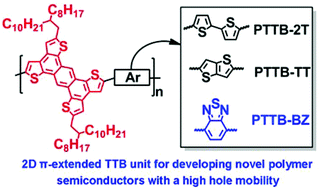In most instances, modulation of the π-conjugation length in polymer molecules is obtained through a linear (1D) extension of the polymer backbone. To date, very limited studies have been reported about the effect of the two-dimensional (2D) π-conjugation extension on the charge-transporting properties of polymer semiconductors. In this study, a 2D π-extended heteroacene, alkyl-substituted tetrathienoanthracene (TTB) moiety, is used to design and synthesize a class of novel polymer semiconductors for solution-processable organic field-effect transistor (OFET) applications for the first time. Three novel TTB-based alternating copolymers (PTTB-2T, PTTB-TT, and PTTB-BZ) are synthesized via Pd(0)-catalyzed Stille or Suzuki cross-coupling reactions, affording high weight-average molecular weights of 61.1–78.5 kDa. The thermal stabilities, optical properties, and energy levels, and charge transport properties of the three TTB-based alternating copolymers have been successfully tuned by copolymerization with bithiophene (2T), thienothiophene (TT), and benzothiadiazole (BZ) derivatives. The results indicate that, even with their highly extended π-framework, all the TTB-containing polymers show good solubility in most common solvents and fairly good environmental stability of their highest occupied molecular orbitals (HOMOs) ranging from −5.15 to −5.28 eV. Among the three TTB-based alternating copolymers, the PTTB-BZ thin film exhibits the best OFET performance with the highest hole mobility of 0.15 cm2 V−1 s−1 in ambient air. It can be attributed to the combinations of highly coplanar polymer backbones and strong D–A interactions between TTB donor units and BZ acceptor units, therefore leading to a compact solid-state packing, uniform fiber-like morphology, and a large polycrystalline grain associated with high hole mobility. These results demonstrate that our molecular design strategy for high-performance polymer semiconductors is highly promising.
